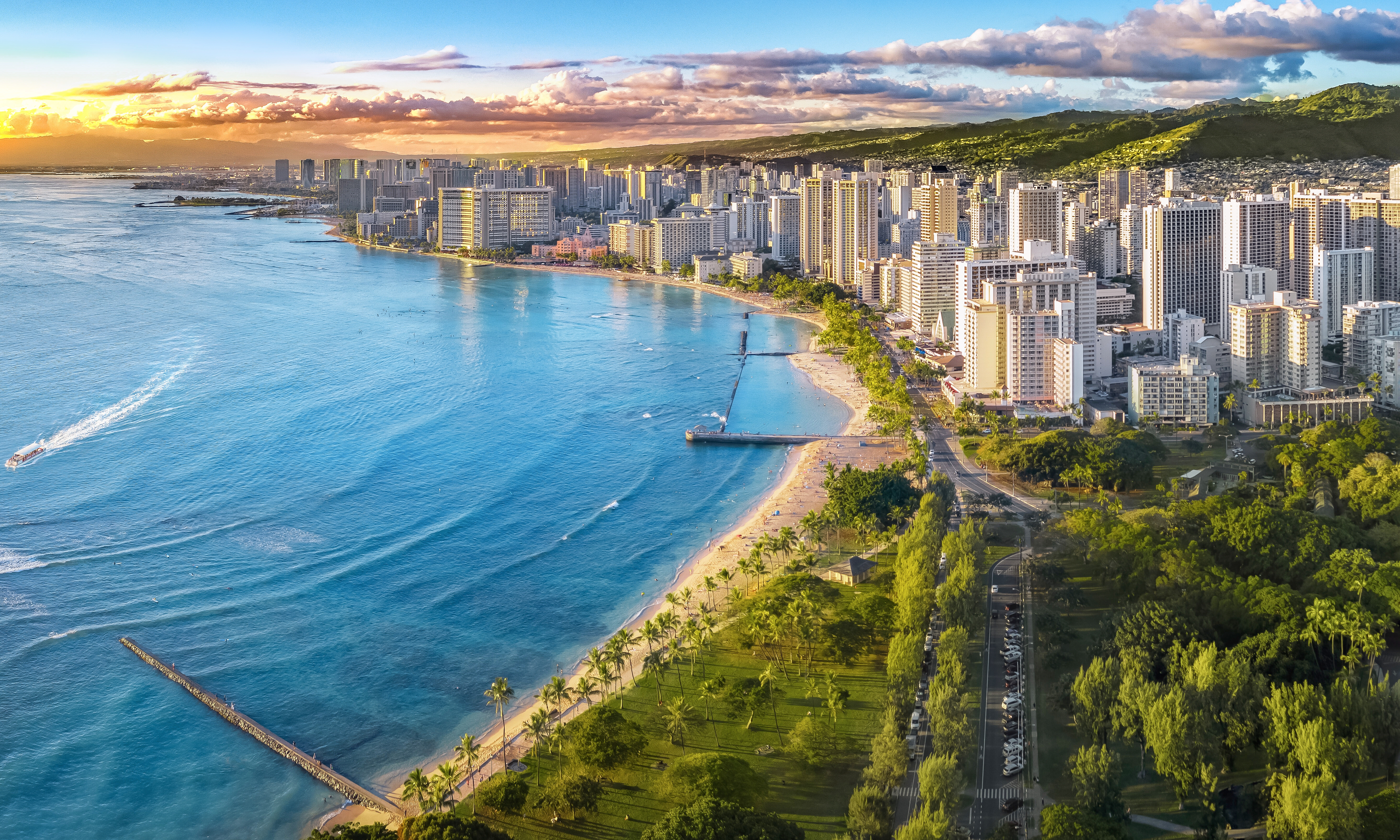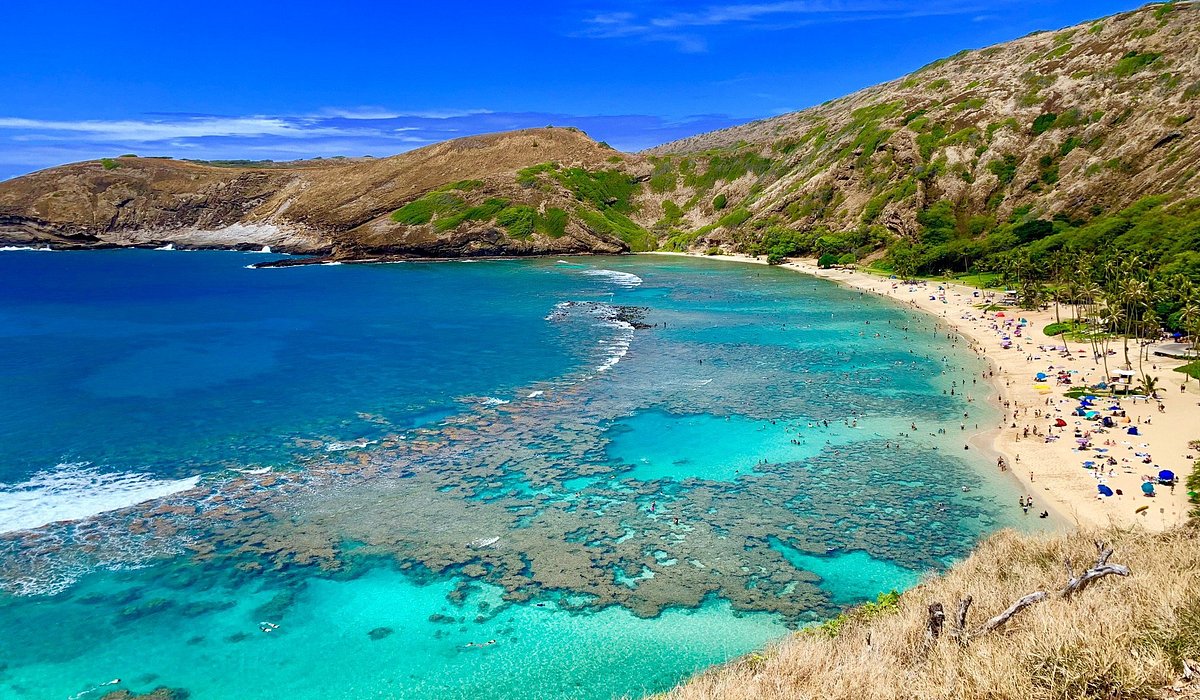



Honolulu, on the island of Oahu’s south shore, is capital of Hawaii and gateway to the U.S. island chain. The Waikiki neighborhood is its center for dining, nightlife and shopping, famed for its iconic crescent beach backed by palms and high-rise hotels, with volcanic Diamond Head crater looming in the distance. Sites relating to the World War II attack on Pearl Harbor include the USS Arizona Memorial. ― Google
Best Months:
April–June and September–November
Fewer crowds, lower prices, and great weather.
Summer (July–August):
Peak tourist season with lots of festivals, but higher prices.
Winter (December–March):
Whale watching season, slightly more rain, and bigger surf on the North Shore.
Main Airport:
Daniel K. Inouye International Airport (HNL) – 20 minutes from Waikīkī.
From Mainland USA:
Direct flights from most major U.S. cities including Los Angeles, San Francisco, Seattle, Dallas, and New York.
From Other Islands:
Inter-island flights via Hawaiian Airlines, Southwest, or Mokulele Air.
From Airport to City:
Taxi, Uber/Lyft, or Shuttle
TheBus (Route 20 or 42 to Waikīkī, slow but cheap)
Car rentals available, but parking can be expensive in Waikīkī.
Waikīkī Beach – Iconic crescent-shaped beach, great for swimming and beginner surfing.
Diamond Head Crater – Moderate hike with panoramic city and ocean views.
Pearl Harbor National Memorial – Visit the USS Arizona Memorial and WWII museums.
Iolani Palace – The only royal palace in the U.S.
Hanauma Bay Nature Preserve – Excellent snorkeling with vibrant marine life.
Honolulu Museum of Art – Art and culture from across the Pacific and Asia.
Bishop Museum – Hawaiian history, culture, and science exhibits.
Manoa Falls – Lush rainforest hike to a 150-ft waterfall.
Ala Moana Center – Hawaii’s largest open-air shopping mall.
Kakaʻako Murals & Street Art – Trendy neighborhood filled with art and breweries.
Surf or paddleboard in Waikīkī (rentals and lessons available).
Snorkeling & Scuba diving at Hanauma Bay or Magic Island Lagoon.
Take a catamaran cruise at sunset.
Hike to the top of Diamond Head for sunrise.
Watch a traditional hula show (free ones happen nightly in Waikīkī).
Visit a luau like Paradise Cove or Chief's Luau for food + culture.
Explore Chinatown Honolulu – Food, art galleries, nightlife.
Kayak or paddle to Mokulua Islands (from Kailua Beach).
Visit the North Shore – Famous for big waves and a chill surf vibe (1 hr drive).
Whale watching (Dec–March) or sea turtle spotting (year-round at Laniakea Beach).
Luxury:
Halekulani – Iconic Waikīkī oceanfront luxury.
The Royal Hawaiian – “Pink Palace” of the Pacific.
Prince Waikīkī – Modern and high-end with harbor views.
Mid-range:
Outrigger Waikīkī Beach Resort – Beachfront with great dining.
Aston Waikīkī Beach Hotel – Affordable with ocean views.
Queen Kapiolani Hotel – Stylish and close to Diamond Head.
Budget:
The Surfjack Hotel – Retro-chic and centrally located.
White Sands Hotel – Trendy with vintage island charm.
Polynesian Hostel – Good for backpackers, steps from the beach.
Other Areas to Stay:
Waikīkī: Most convenient and tourist-friendly.
Downtown Honolulu: Business district, not beach-focused.
North Shore: Quiet and scenic, better for extended stays or surfing trips.
Must-Try Hawaiian Foods:
Poke bowls – Ono Seafood, Maguro Brothers, Tamashiro Market
Plate lunch – BBQ chicken, kalua pork, rice, and mac salad
Spam musubi – A local snack (Spam + rice wrapped in seaweed)
Malasadas – Portuguese donuts at Leonard’s Bakery
Shave ice – Try Waiola Shave Ice or Island Vintage
Loco moco – Rice, burger patty, egg, and gravy — local comfort food
Top Restaurants:
Alan Wong’s Honolulu – Upscale Hawaiian fusion
Roy’s Waikīkī – Hawaiian regional cuisine
The Pig and the Lady – Creative Vietnamese fusion in Chinatown
Helena’s Hawaiian Food – Authentic local food (James Beard award)
Marukame Udon – Fast, fresh noodles in Waikīkī
Highway Inn – Classic Hawaiian fare
Duke’s Waikīkī – Beachfront, casual, fun vibes
Aloha Spirit: Locals are warm and welcoming; respect and kindness go a long way.
Native Hawaiian Traditions: From hula and mele (music) to lei-making and ʻŌlelo Hawaiʻi (Hawaiian language), the culture is deeply rooted in the land and sea.
Multicultural Influence: A melting pot of Hawaiian, Japanese, Filipino, Chinese, Korean, Portuguese, and Polynesian communities.
Respect for Nature: Locals care deeply about preserving the islands. Don’t touch coral reefs or leave trash behind.
Important Terms:
Aloha – Hello, goodbye, love.
Mahalo – Thank you.
Ohana – Family.
Pono – Righteousness, balance.